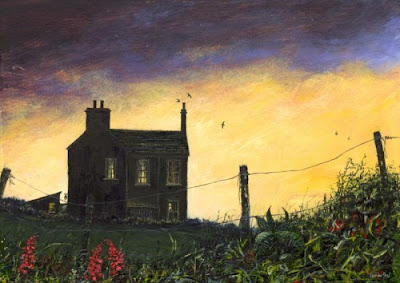In July last year, AiH trustee Gavin McEwan wrote a blog about the role of a charity’s board of trustees, how they safeguard the organisation’s activities, its legal and financial accountability. It would be fair to say that despite their considerable governance and managerial power, the identity of the trustees often remains largely unknown.
It would be equally fair to say that the exact opposite is true of the patron. Recently, prominent painter and Royal Academician Barbara Rae RA CBE RE who featured in the ‘Artist Uncovered’ blog of March this year, accepted Art in Healthcare’s invitation to be their patron. This is a good opportunity to reflect on what the role means.
Mull Ferry by Barbara Rae watercolour, 105x88cm
Art in Healthcare collection
The idea of patronage has evolved since and today what charities look for in a patron is an individual who not only commands public attention, but is also passionate about what they stand for and can promote and lend credibility and weight to their cause. The royal family is a good example of such patronage.
I asked Barbara Rae what this appointment meant for her and she replied:
“Besides being an important charity in itself, without one like AiH hospitals would be barren, antiseptic places. It is essential patients and visitors have some visual stimulus that lifts the spirit, takes their mind off their immediate health problem, even momentarily.In ward or waiting room art can make the difference between gloom and hope. A good art image is always superior to a No Smoking sign.”
Ballachulish 1 by Barbara Rae monotype, 87x70cm
Art in Healthcare collection
To be a patron has a definite air of glamour about it. But like any other ‘job’ it depends on a good relationship between the two parties to fulfil their mutual expectations and any appointment will be preceded by an exchange of documents that spell out clearly what is required from each party. Typically, these documents will outline how to maintain the flow of communication with regular updates from both sides, how many events the patron will be asked to attend per year and how the charity will make use of the patron’s name and picture.
Magic Happening no1 by Alan Davie gouache, 93x81cm
Art in Healthcare collection
This appointment is a momentous occasion in the history of AiH as Barbara Rae is only their second patron. Their other patron, Alan Davie, was appointed by Paintings in Hospitals in the mid 1990s and stayed with AiH after its creation at the start of the new millenium. This new development also indicates a significant period of growth for the organisation as it continues to expand geographically and in its range of services.
Martine Foltier Pugh is a freelance writer and visual artist based in Edinburgh.
With thanks to Barbara Rae.
Royal Academy http://www.royalacademy.org.uk/
Royal Society of Painter-Printmakers http://artmondo.net/printworks/workshops/re.htm
Royal involvement with patronage http://www.royal.gov.uk/charitiesandpatronages/royal%20involvement%20with%20charities/royal%20involvement%20with%20charities.aspx
The House of Medici http://en.wikipedia.org/wiki/House_of_Medici
The Stein family http://www.sfmoma.org/about/press/press_exhibitions/releases/862
Yin and Yang http://www.bbc.co.uk/religion/religions/taoism/ataglance/glance.shtml







+blue+ark.jpg)

